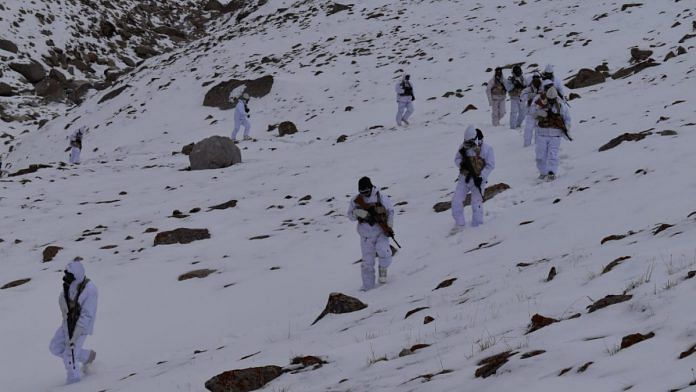New Delhi: Raised soon after the India-China war began in 1962, the Indo Tibetan Border Police (ITBP), which guards the 3,488 km long Line of Actual Control (LAC), has grown in size and role over the last 60 years.
The ITBP, which was raised on 24 October 1962 under the CRPF Act, just four days after the war began, in its role as the first line of defence staved off the Chinese aggression along northern and eastern sectors of LAC in the subsequent years.
Even in the ongoing tensions at the LAC, the ITBP has played a critical role and were awarded with 20 gallantry medals for their action against Chinese troops in 2020.
As of today, the ITBP has 180 border outposts on the India-China border.
While the ITBP is under operational control of the Ministry of Home Affairs (MHA), it works closely with the Army. The Army has been wanting the ITBP to be brought under its operational control, a demand that has been strongly contested by the MHA.
Among all the central armed police forces (CAPF), ITBP is unique as it is a mountain trained CAPF which specialises in border guarding in hazardous and inhospitable terrain and weather conditions that mark the border outposts located up to 18,900 ft in the Himalayas.
The ITBP is also deployed in anti-naxal operations, general law and order duties, search and rescue missions and VIP protection among others.
Also Read: What does a ‘lead role’ for ITBP at LAC imply? Two things, and why neither will work
Rich history
The ITBP has taken part in the India-Pakistan wars of 1965 and 1971 as well as counter insurgency operations in Kashmir.
Sixteen years after the force was raised, the government restructured the ITBP in 1978 to have 9 service battalions, 4 specialist battalions and 2 training centres.
During the 9th Asian Games held in 1982 in New Delhi, ITBP was tasked with providing security, including to the participants arriving in the city.
Based on the experience, the force was deployed for anti-terror security coverage during Commonwealth Heads of Government Meeting and the seventh Non-Aligned Movement meeting at Delhi in 1983 amid insurgency in neighbouring Punjab.
In 1987, 6 battalions of ITBP were raised to stop bank robberies perpetuated by terrorist and extremists in Punjab. Two years on, the ITBP personnel were inducted for counter-insurgency operations in Jammu and Kashmir, which they did till 2004.
While the force was raised under the CRPF Act, Parliament enacted the ITBP Act in 1992, and the rules under it were framed in 1994.
It was in 2004 that the ITBP was assigned to secure the entire stretch of 3,488 km of India-China border from Karakoram pass in Ladakh to Jachep La in Arunachal Pradesh. In the process, the ITBP replaced Assam Rifles in Sikkim and Arunachal Pradesh in the eastern sector of the LAC.
The government made this decision in pursuance of a Group of Ministers’ (GOM) recommendations of ‘One Border One Force’ in the aftermath of the 1999 Kargil War.
Structure & current role
Headed by a Director General, the force has 3 Additional Directors General and 23 Inspectors General. Currently, ITBP has 56 service battalions, 4 specialist battalions, 2 NDRF battalions, 17 training centres and 7 logistics establishments with a total strength of 88,430 personnel.
These battalions are organised under 15 sectors each headed by a DIG, 5 frontiers each headed by an IG and 2 commands each headed by an ADG.
The ITBP has three basic roles which includes border guarding for which 32 battalions are deployed. Eight battalions are deployed for anti-naxal operations while 16 are engaged in internal security duties. The force is also assigned with VIP protection and currently has 14 protectees.
The ITBP has been serving the United Nations Peacekeeping Missions since 1989, with hundreds of its officers serving at the missions over the years in many war-torn nations.
It safeguarded the High Commission of Colombo from 1988 to 2005 and also served in Congo from 2005 to 2019.
The personnel from the force were also deployed from 2002 to August, 2021 in Afghanistan to provide security to the Indian Embassy in Kabul and four Consulates Generals.
In 2004, ITBP was deployed at Gurguri, Minar and Zaranj in Afghanistan to provide security to the men and machines engaged by the Border Roads Organisation (BRO) for the Delaram-Zaranj road construction project.
In its role as first responders in any disaster in the Himalayan region, the force has carried out 113 rescue operations in the last four years in which 4,148 people were rescued and 186 bodies retrieved, ITBP sources said.
The ITBP has also been involved in the fight against the Covid pandemic and established India’s first quarantine centre in New Delhi in January 2020.
Its referral hospital in Greater Noida was declared as a Covid care centre and hospital to treat all serving and retired CAPF personnel and their families. The force also managed, what the ITBP sources claim, was the world’s largest Covid care centre at Radha Soami Beas in Chhatarpur, New Delhi during the three waves of the pandemic.
Also Read: Don’t give ITBP lead role at LAC, it will weaken local command. MHA-MoD turf war is hurting



